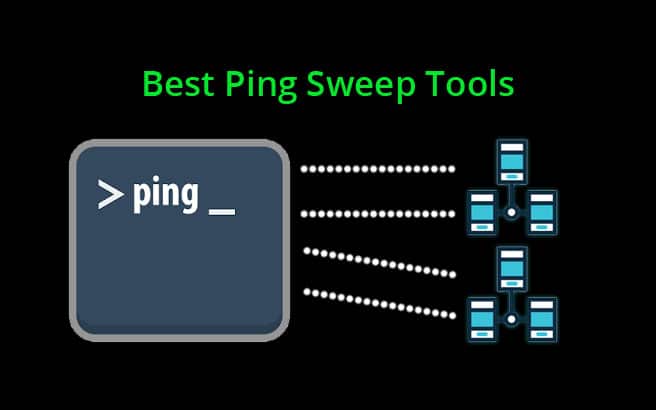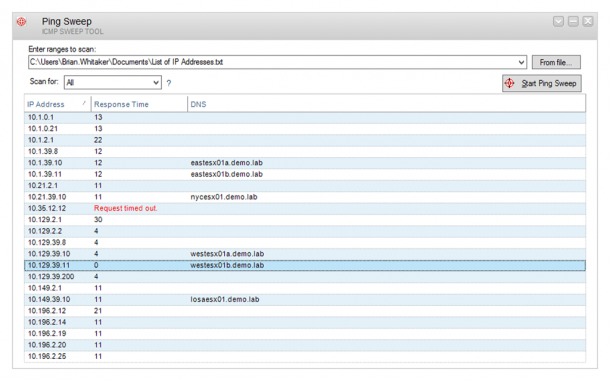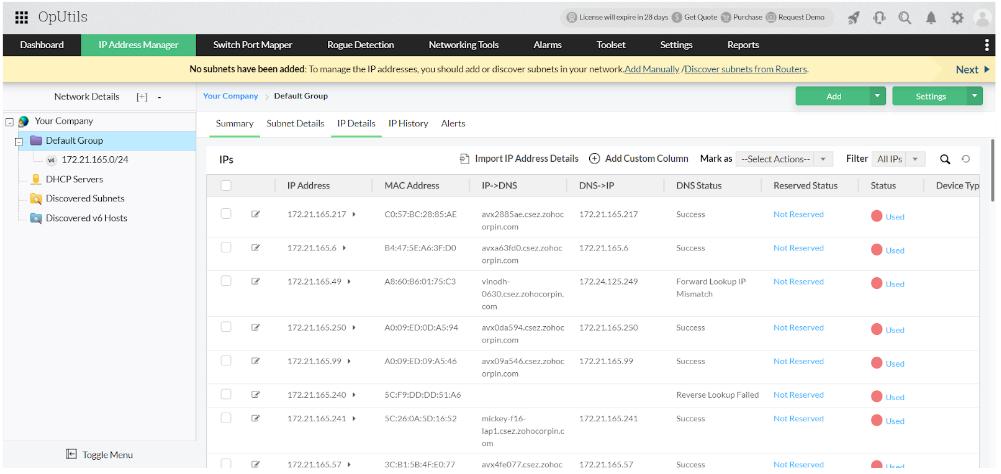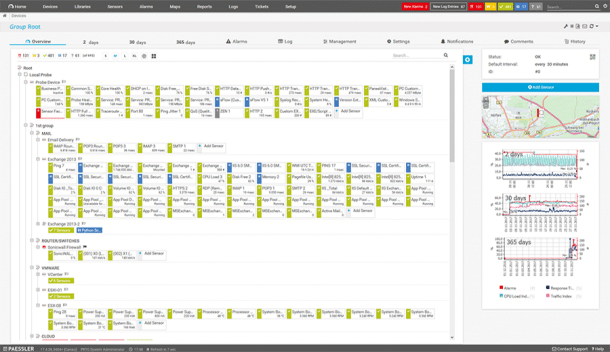For getting the list of live IP addresses available on your network, a simple method is used, called Ping sweep.
The results of active and turned on hosts are returned by Ping sweep tool which is then used for recovering abandoned addresses in your DHCP server.
Here is our list of the best Ping sweep tools:
- SolarWinds Ping Sweep Tool – FREE TRIAL This network discovery tool is part of the Engineer’s Toolset. It identifies all active IP addresses and lists them with response time and DNS entries. Installs on Windows Server. Download the 14-day free trial.
- SolarWinds IP Address Scanner – FREE TRIAL This tool can be used as a standalone IP address scanner or together with the IP address manager with which it is bundled. Installs on Windows Server. Download the 30-day free trial.
- ManageEngine OpUtils – FREE TRIAL A package of network address monitoring and management tools, available in free and paid versions. Runs on Windows Server and Linux. Download the 30-day free trial.
- Paessler PRTG – FREE TRIAL A package of network, server, and application monitors that includes a Ping sweep tool. Installs on Windows Server. Download the 30-day free trial.
- Zenmap A partner with Nmap that shows a range of network monitoring data, including a sweep of IP addresses using Ping. Installs on Windows, macOS, and Linux
- Fping A command line Ping sweep tool for Linux. Free to use.
- Network Pinger A free package of network investigation tools including an IP scanner, a Ping tool, and TraceRoute. Installs on Windows Server.
- Hping A free command-line tool that performs the Ping command recursively on a range of IP addresses. It is available for Windows, macOS, Linux, and Unix.
The Best Ping Sweep Tools
Below we have compiled a list of some Best Ping sweep Tools and Software available today, so let’s check them out.
1. SolarWinds Ping Sweep Tool – FREE TRIAL
SolarWinds is a leader in producing network software and its Ping Sweep tool is a tool from one of their network management toolset. SolarWinds Engineer’s Toolset comprises of more than 60 tools for managing and monitoring a network and Ping Sweep is of the tool from this package. It has a straightforward interface where you just need to enter an IP address range for scanning.
If you are not sure about the scope of total IP addresses in use, then you can also specify a large range of addresses. By inputting a list of IP addresses in a text file, you can get the output as a list of all the IP addresses that’s been allocated by the DHCP server. A list of active IP addresses on the network is found by the tool once the search is launched. You can export the result of sweep as CSV file, XML file, text file or as an HTML page. This list can be imported to a spreadsheet for comparing it with the list of DHCP servers. If you subtract the result of Ping Sweep from the result of DHCP you will get the list of IP addresses that are abandoned.
You can restore those addresses in your DHCP server along with the other available addresses. The results of the Ping Sweep show the response time of each host. The problems experiencing in each piece of equipment or your network’s traffic bottleneck is highlighted by the response time. Also, you get the hostname of all the detected devices.
This Ping Sweep tool is not available for purchase alone, you need to buy it with Engineer’s toolset and install on your Windows server. However, it has a 14-dayfree trial which is fully functional without any limitations.
2. SolarWinds IP Address Scanner – FREE TRIAL
Scanning the IP address is an important part of any IPAM (IP Address Manager). SolarWinds IP Address Scanner is a part of its IPAM suite. SNMP strategies and ICMP Ping are combined in this tool for maintaining a clean list that contains the available IP addresses. You can set the tool to automatically run in the background so that there is no waiting for the process to finish. Also, the address management pool of the IP addresses that are available will be manually updated by the scanner. The complete IPAM suite works with IPv4 and IPv6 addressing.
IPAM dashboard shows live reports of all the IP addresses that are currently active and maps them to the hostnames that are registered in the DNS server. It offers a complete DDI solution by preventing reuse of active addresses by your DHCP server and also reconciling to DNS records to ensure that hostname mappings do not contain any dead addresses.
Orion is the common platform that’s used by SolarWinds and for writing the IP address manager’s screen. As they both share a unified platform so IPAM module can be integrated with any other SolarWinds product. The tool can be installed on Windows Server and a 30-day free trial is also available.
3. ManageEngine OpUtils – FREE TRIAL
ManageEngine OpUtils is a collection of tools that monitor and manage all the addresses used on a network. These address types include IP addresses, MAC addresses, and TCP/UDP port numbers.
The suite of utilities includes a set of screens for IP address management. One of the screens in this group is an IP address scanner that uses Ping to detect all of the devices connected to the network. The scanner just works through all possible addresses on a private LAN and records each Ping request that gets a response.
For each response to a Ping request, the scanner then performs extra checks. The service finds the associated MAC address for each IP address that gets a positive hit and it also references the local DNS records to get the hostname of the device.
OpUtils also includes a full IP address management system. This is able to reconcile used IP addresses with the records in your Microsoft DHCP server. This service is useful in order to make sure overlooked abandoned IP addresses are returned to the list of available addresses.
Another feature of the OpUtils package is a switch port-mapper. This explores the network, encountering all of its switches. Querying each switch, the service can log all of the devices connected to it, listing their MAC addresses. By tracking the switches that are connected to each other, the switch port mapper is able to build up a full topology map of the network.
The OpUtils system is a paid product. However, there is a less comprehensive version of the package that is available for free. Both editions of OpUtils are available for installation on Windows Server and Linux and are available for a 30-day free trial.
4. Paessler PRTG – FREE TRIAL
Paessler PRTG is a comprehensive tool for system monitoring that employs several techniques to map the networks and connected devices. Also, PRTG has the ability to monitor the performance of web services and applications. The tool also extends its visibility to remote sites and online services.
PRTG uses many systems and protocols but Ping is its core. The installation of PRTG completes with a discovery phase where every connected device in a network is tracked and recorded in a register. The connections between the devices are compiled in a network map by the PRTG software.
One IP address is contacted by standard Ping. Any operating system incorporating network services can avail this system command. You can perform a Ping query if a network connects your computer. Ping command is putted in a looped routine by Paessler to get be in touch with all the nodes present on a network. Sequentially the Ping sensor works through each network address that’s feasible and issues a Ping there. If any response is received by the sensor that shows that the address is working then further queries are performed for collecting detailed information about the representing device.
The discovery’s start point is ping sweep. There are other tools that work in the detailed characteristics of each device. Detailed information on each device along with their current statuses is provided by the SNMP system. So, this Ping sweep tool by Paessler works along with other utilities and protocols for mapping your network.
You can install PRTG on Windows Server; also you can use it as a cloud service. You need to implement a group of sensors to use this system. The Ping sensor is one of them. PRTG is free for up to 100 sensors. For more sensors, you need to pay. Start by downloading the 30-day free trial.
5. Zenmap
Nmap is a command-line tool that is available as a. Zenmap is Nmap’s GUI version, thus it’s easy to use. You can install the software on Windows, MacOS, Linux, Unix and OS.
A profile dictates the scan format that specifies the search parameters. Several profiles are already set in the Zepmap GUI, but you also get the option of creating your scan details just by editing the already existed profile and then saving the profile as a new one. Scans can be performed by Zenmap with Ping as well as TCP. Depending on the profile, you will get a different layout as the output of the scan. Also, you get the list of IP addresses of all the active hosts along with the hostname for every device. You can change the scan to used TCP to know the open ports on your router or computer.
In the interface, the first tab shows the raw Nmap output of the Nmap process that’s underlying. Although those details are not easy to read and understand, but all the other subsequent tabs interpret the data as records for easy reading. Topology Mapper is one of the formats for displaying your network links in a graphical representation. You can store the results of Zenmap as XML files using this tool.
6. Fping
Fping is a sweep tool for Linux that’s based on the command line. This software is free and needs a range of IP addresses as a parameter for starting the sweep. Also, you can enter the range using CIDR notations containing a combination of mask length with the IP address, like 221.185.3.1/15. Alternatively, a list of IP addresses can be prepared in a file and put it in the command. Your DHCP server can provide you a report of IP allocation and you can feed that report in Fping.
With the switches in this utility, you get the ability of limit the sweep for just IPv6 or IPv4 addresses. Also, you get the option for specifying the appearance of only active hosts in the list, or all the IP addresses there in the range that are inactive and labeled as being unreachable. The output can also be linked to DNS records by this tool. It shows the hostname for the IP addresses that are encountered. If the hostname is missing from a record or looks something wrong with the DNS, then you can the problems with DNS.
Although it’s an on-demand sweep tool, but you can run this tool as a cron job or put the command in the batch file to schedule runs.
7. Network Pinger
Network Pinger is a Windows-based tool that’s free to use. A range of addresses is required by the scanner as input and it is expressed in CIDR notation as a subnet. This tool pings all the addresses in a sequence and provides reports of the responses.
The output is shown by the interface as it serially pings and progresses through the range of IP addresses. The dashboard has graphical displays that show the response rate of each ping. The percentage of both reached and unreachable addresses are shown by a pie chart. The graphical representations present in this ping sweep tool are very useful as it makes it easy for the users to quickly know about the health of the network.
With Network Pinger you can issue ping only to a single IP address too. Also, you get switch port mapper and Traceroute function as a built in feature. In the planning features, you get a statistical analysis report and IP calculator. This tool comes with many helpful diagnostic tools to help you find solutions to the communication problem by investigating your network health.
8. HPing
Hping is a free command-line tool that will appeal to those network administrators who have long-served and used to use commands as Traceroute and Ping commands. Hping3 is the latest version of Hping. Hping3 is also free and installs on Windows, Mac OS, Unix and Linux. Hping sends a ping request to a given range of IP addresses. UDP and TCP messaging abilities allow you to do port tests on your routers or computers. Also, it incorporates Traceroute implementation.
Being a command-line ping utility, the output can be piped to a file for further analysis. The tool includes many commands like it can translate hostnames to their IP addresses and can also text the firewalls.
This tool appeals the hackers as it can help them to collect information from a target computer and can be used for launching a service attack denial. It diminishes the image of hping a bit. But that does not mean that you should not use this tool to know about your network and devices.
9. Angry IP Scanner
The Angry IP Scanner sweep tool is very popular and recommended by professionals due to its fast scanning speed. Its interface could probably be another reason for the popularity of this tool. The list of results provided by the dashboard is straightforward and somewhat similar to the presentations given by command-line utilities that are preferred by highly experienced technology experts. And the GUI systems window-based fonts make it easy to read the output.
This network analysis tool is free to use and can be installed on Linux, Unix and Windows. The sweep of a specified range of IP addresses is done by this tool in CIDR notation. Also, a random or non-consecutive list of IP addresses can be checked by this tool when given as an input file. You can save the output in XML, CSV, IP-Port and TXT format.
Each IP address present in the requested range, whether contactable or not is shown by the standard Ping sweep tool. If a Ping’s round trip time is absent for that record, it indicates the missing addresses.
The DNS resolution displays the hostname of the requested address if it finds it. If a record has missing hostname but the IP address was contactable then it should raise alarm as it shows that DNS records are outdated or intruder is there on the network.
Conclusion
Clearly there are many Ping Sweep tools to choose from and It’s quite difficult to manage an IP space without using any of these tools.
So select a tool based on the size of your business and requirements and give it a download to test in your environmen.
All the above tools are great and highly useful depending on one’s needs, we suggest you download a couple of them to get started to see which one fits the bill for your specific environment!









